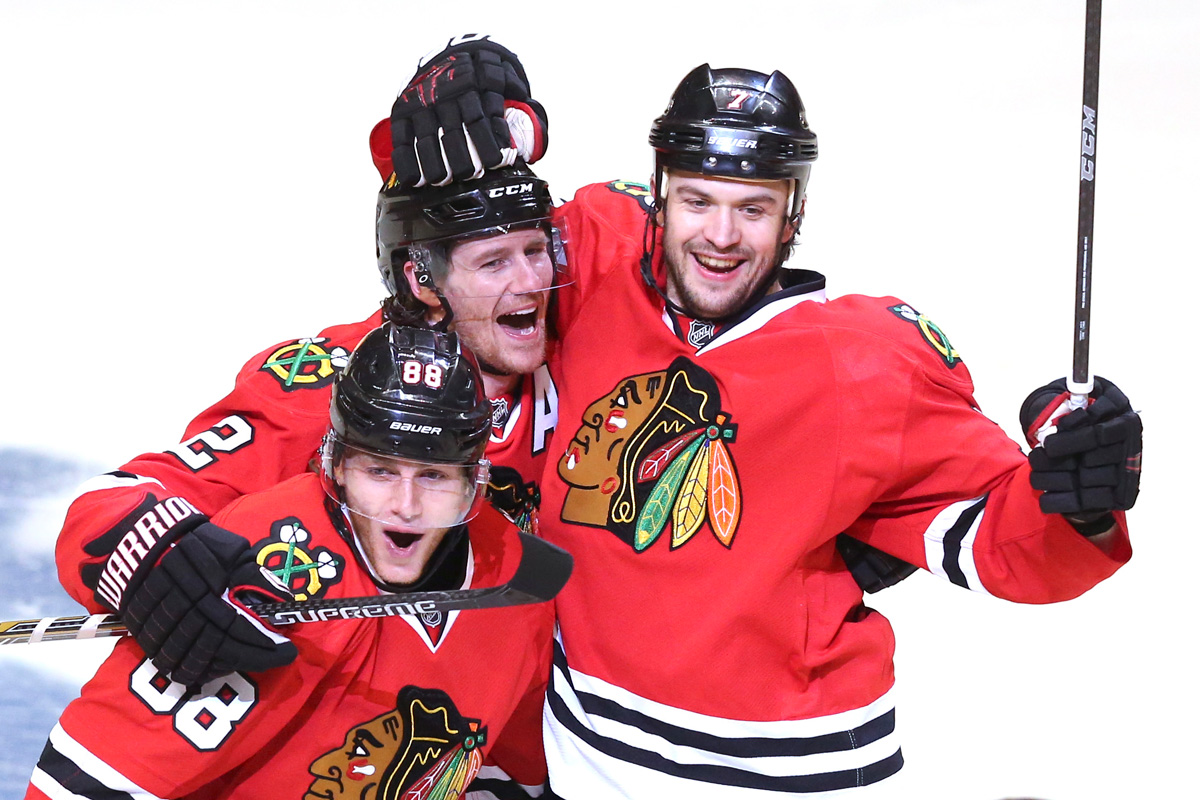This Sunday the Blackhawks will enter the Western Conference Finals against the Anaheim Ducks for a shot at the championship—and their third Stanley Cup in five years. That's a remarkable feat for a team that, just a decade ago, was floundering for fans and attention. Back in 2007, the team ranked 118 of 122 of fan-favorite sports franchises in America, according to ESPN the Magazine.
Two Stanley Cup wins later, America (except for Detroit and St. Louis, maybe) loves the Blackhawks. Jonathan Toews, Patrick Kane, Duncan Keith, Patrick Sharp, and Brent Seabrook are credited with reigniting competitive hockey in Chicago, and two years ago Sports Illustrated dubbed the Chicago Blackhawks “The franchise that brought hockey back.”
Blackhawks’ Rankings for Fan Friendliness
Since 2013 ESPN the Magazine has ranked fans’ opinions of the 120-odd major sports teams. (Hockey teams were excluded in 2005-2006 because of the labor dispute.) From next-to-last in 2004 the team has climbed to 10th in 2014 following Stanley Cup victories in 2010 and 2013.

So how did the Blackhawks, once dubbed one of the worst-run franchises in pro sports, become one the best?
A lot changed back in 2007, when longtime team owner Bill Wirtz—nicknamed "Dollar Bill" for his greedy attitude—passed away, leaving the franchise to his son Rocky. Bill had done everything possible to alienate fans, from blacking out home games from TV (so people would have to buy tickets and watch the team in person) to trading popular players and overpaying for over-the-hill ones. Rocky, meanwhile, used fresh eyes to evaluate things. He turned to the former Cubs executive John McDonough and team consultant Scotty Bowman, a coaching legend in his own right. They immediately struck a deal to televise more games, planned an outdoor match at Wrigley Field, and rehired some key people who had been fired or left during the Bill era. Finally, the new owners made it clear that they would focus on winning the Stanley Cup, not the bottom line.
Televising more games, hiring back personalities, and playing at new venues was only half of it though. Most fans may not believe this, but the team took on the hockey operations model of the hated rival Detroit Red Wings. When the Red Wings had their run in the late ’90s, they drafted a core group of players to root for—superstars such as Steve Yzerman and Nicklas Lidstrom. Some were star players, some were role players, and they also had a solid but relatively inexpensive goaltender. When the Blachawks basically relaunched in 2007, they added made-for-TV Patrick Kane to the roster.(Fellow all-star rookie Jonathan Toews had been added the previous year). Even when the team came up against a salary cap in 2010 and had to jettison popular role players, they focused on developing young players via the minor leagues. When players such as Andrew Ladd, Dustin Byfuglien and Antti Niemi left, players such as Brandon Saad and Corey Crawford were ready to step into prominent roles.
The Blackhawks also hit the perfect storm with timing. Just as the team was on the upswing, so was social media, and the Blackhawks took full advantage, engaging with fans across Twitter (currently 863,000 followers) and Facebook (2.5 million likes)—a strategy Bill Wirtz surely would have probably deemed a waste of time. Add to that a TV show—Blackhawks TV, which airs after games—along with events across the city and interest skyrocketed.
How much? Since the 2008-09 season, the Blackhawks have led the NHL in attendance. The previous year, 2007-08, the team finished at No.19, the year that Kane and Toews made their NHL debuts.
Together, Kane and Toews changed the hockey landscape in Chicago. The young players (both started in their early 20s) helped lure millennial fans to the United Center, and their excellent gameplay has helped their jerseys make it to the top-five bestsellers in the past season.
With their rise came a change in attitude for the rest of the team. The Blackhawks now play a brand of hockey that many of the game’s purists have a hard time accepting. They don’t have a full-time enforcer on their roster (John Scott, traded three seasons ago, ended that phase). They are all about puck possession, which creates chances to score goals. They're also not an overly physical team. Many long-time fans want to them to be a little tougher. Some of the fanbase wants more hits. But if a team is spending too much time being physical, that means they are chasing the puck.
They're not alone in that shift—none of the five past Stanley Cup winners have been full-time goon—but they've also endeared themselves to the national hockey scene. The NHL, which looks for any positive PR they can, often uses the Blackhawks in multiple nationally televised games—20 at last count. That’s more than any other NHL team.
The love affair continues at the Blackhawks await their game against the Ducks in the Western Conference Final. Win or lose, the love the team has gotten from the fans is unlikely to subside.



